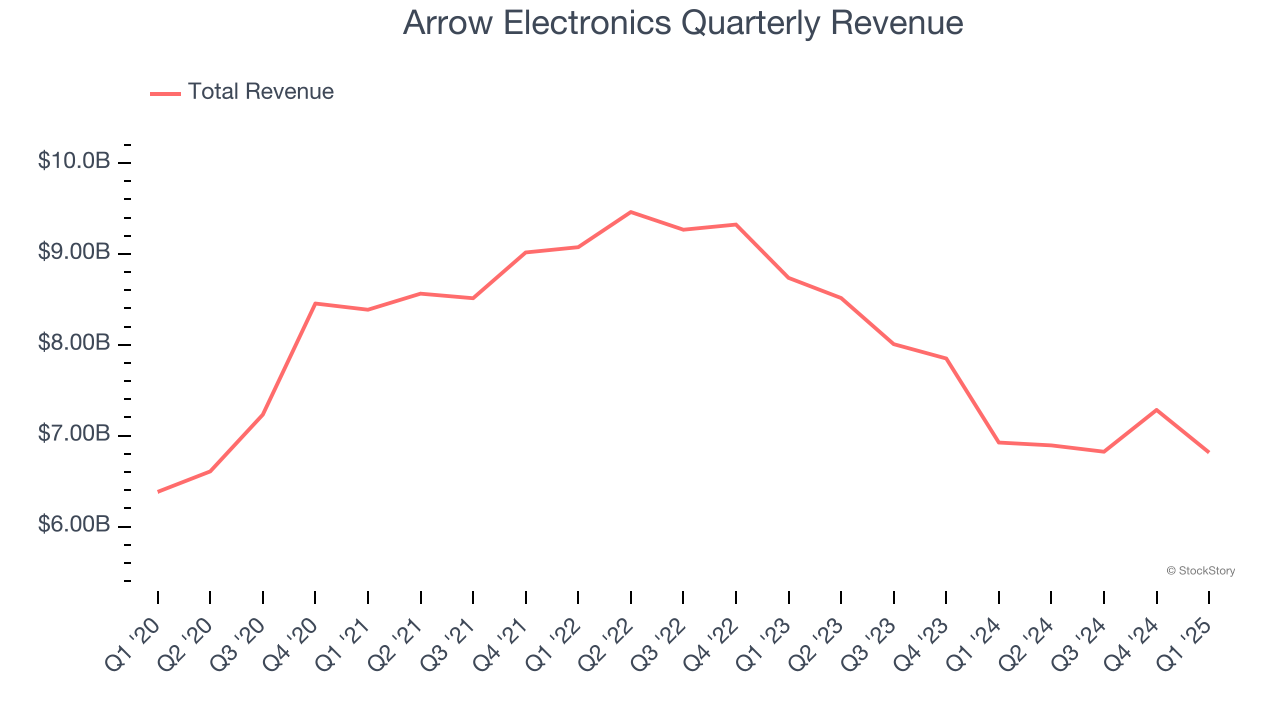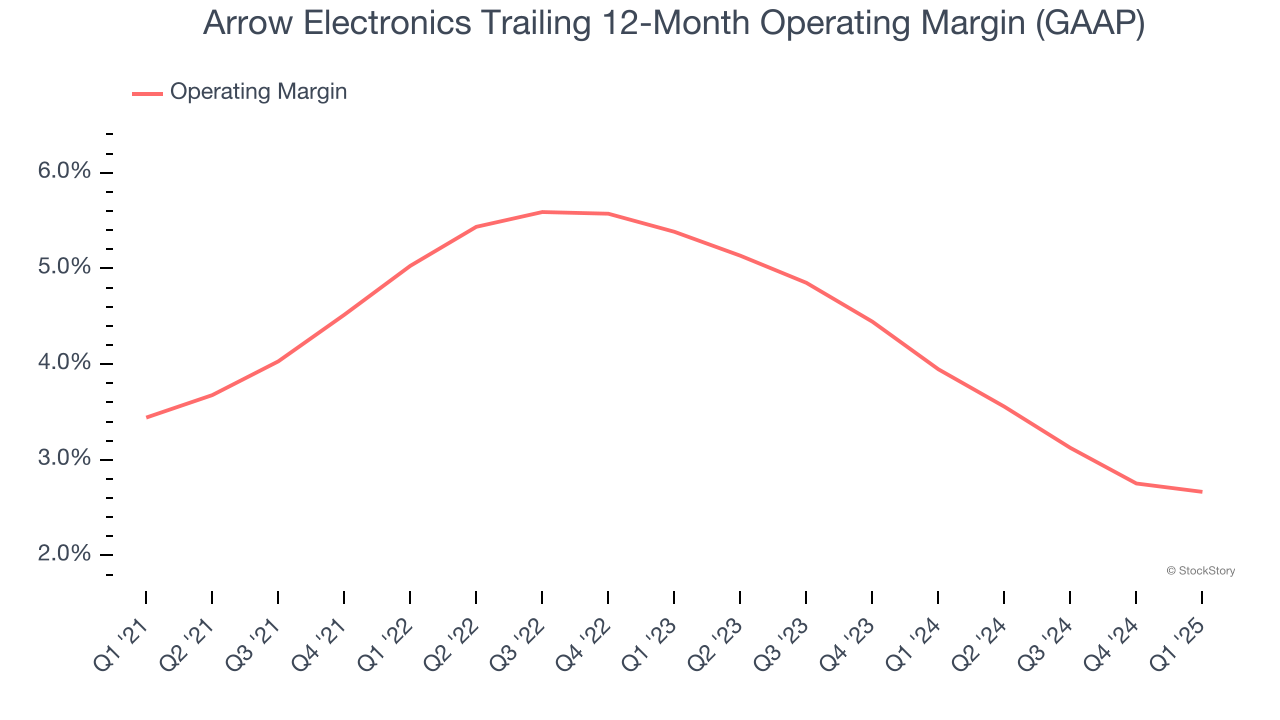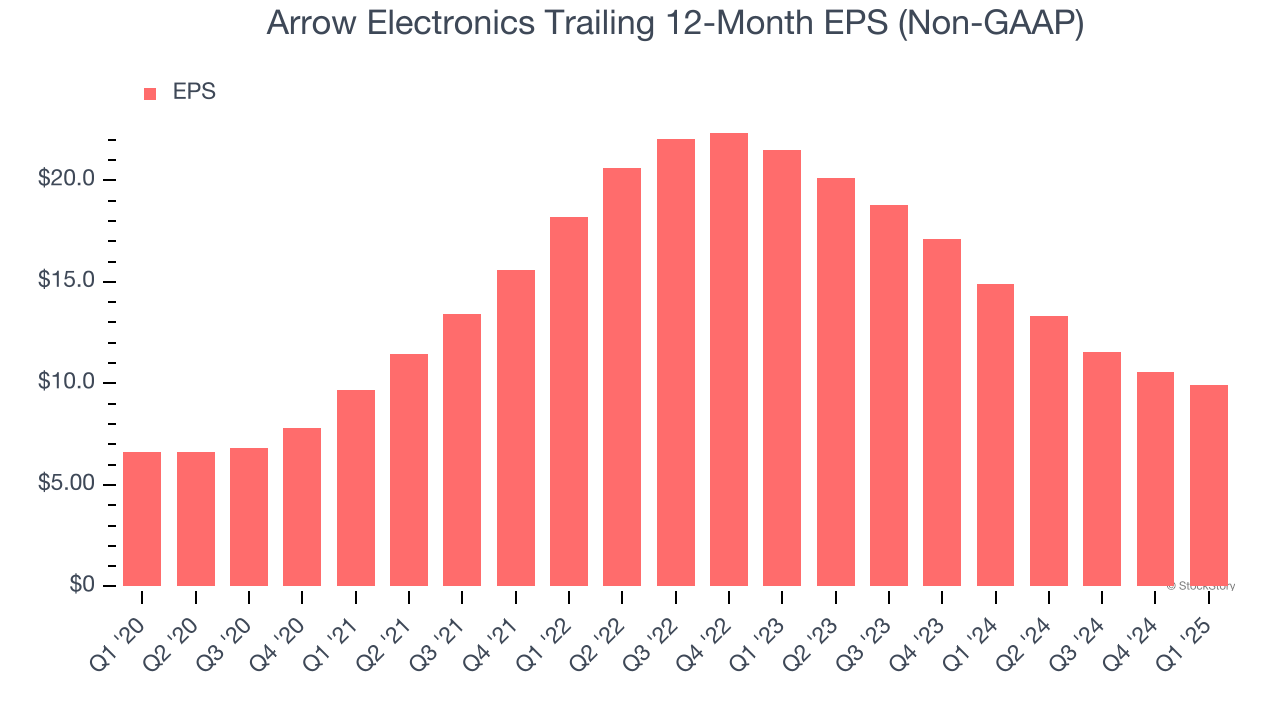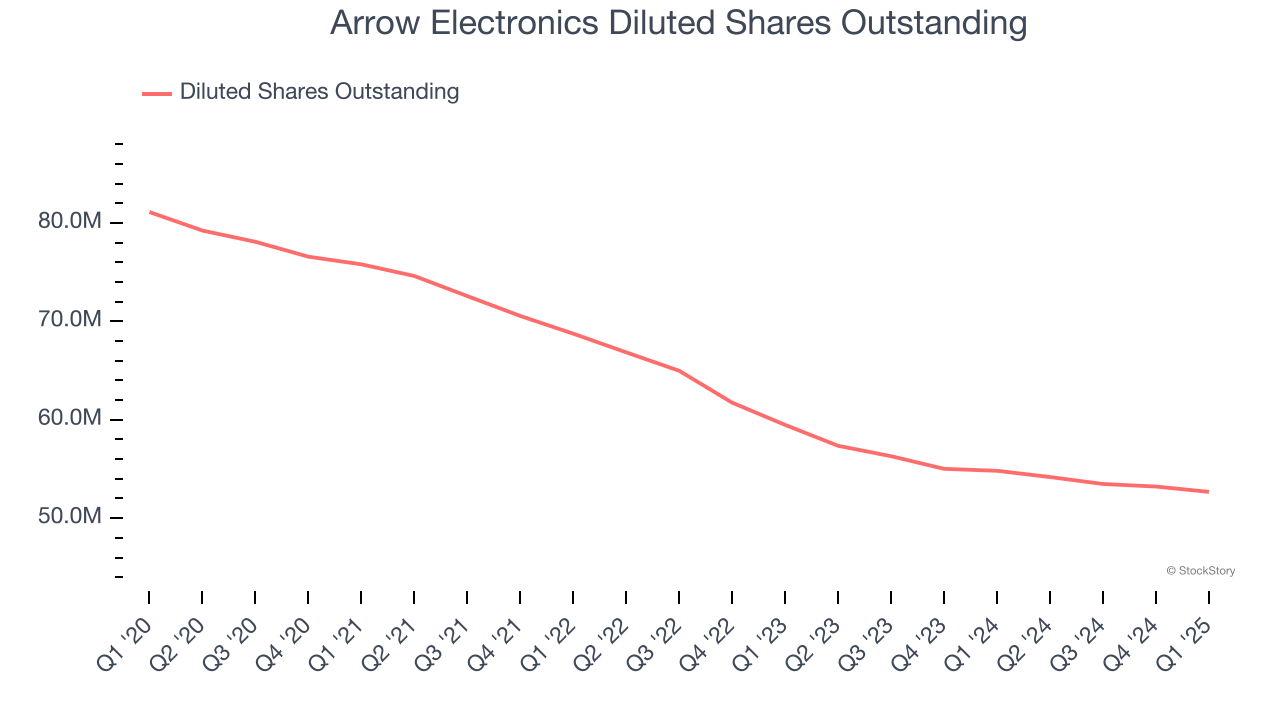
Global electronics components and solutions distributor Arrow Electronics (NYSE:ARW) reported Q1 CY2025 results topping the market’s revenue expectations, but sales fell by 1.6% year on year to $6.81 billion. On top of that, next quarter’s revenue guidance ($7 billion at the midpoint) was surprisingly good and 4.4% above what analysts were expecting. Its non-GAAP profit of $1.80 per share was 25.5% above analysts’ consensus estimates.
Is now the time to buy Arrow Electronics? Find out by accessing our full research report, it’s free.
Arrow Electronics (ARW) Q1 CY2025 Highlights:
- Revenue: $6.81 billion vs analyst estimates of $6.36 billion (1.6% year-on-year decline, 7.2% beat)
- Adjusted EPS: $1.80 vs analyst estimates of $1.43 (25.5% beat)
- Adjusted EBITDA: $194.4 million vs analyst estimates of $197.9 million (2.9% margin, 1.8% miss)
- Revenue Guidance for Q2 CY2025 is $7 billion at the midpoint, above analyst estimates of $6.70 billion
- Adjusted EPS guidance for Q2 CY2025 is $2 at the midpoint, below analyst estimates of $2.07
- Operating Margin: 2.3%, in line with the same quarter last year
- Free Cash Flow Margin: 4.8%, similar to the same quarter last year
- Market Capitalization: $5.78 billion
Company Overview
Founded as a single retail store, Arrow Electronics (NYSE:ARW) provides electronic components and enterprise computing solutions to businesses globally.
Sales Growth
Reviewing a company’s long-term sales performance reveals insights into its quality. Any business can have short-term success, but a top-tier one grows for years. Unfortunately, Arrow Electronics struggled to consistently increase demand as its $27.81 billion of sales for the trailing 12 months was close to its revenue five years ago. This wasn’t a great result and suggests it’s a low quality business.

Long-term growth is the most important, but within industrials, a half-decade historical view may miss new industry trends or demand cycles. Arrow Electronics’s recent performance shows its demand remained suppressed as its revenue has declined by 13% annually over the last two years. 
Arrow Electronics also breaks out the revenue for its most important segments, Components and ECS, which are 70.1% and 29.9% of revenue. Over the last two years, Arrow Electronics’s Components revenue (electronic component sales) averaged 16.8% year-on-year declines while its ECS revenue (computing solutions and services) was flat.
This quarter, Arrow Electronics’s revenue fell by 1.6% year on year to $6.81 billion but beat Wall Street’s estimates by 7.2%. Company management is currently guiding for a 1.6% year-on-year increase in sales next quarter.
Looking further ahead, sell-side analysts expect revenue to grow 1.9% over the next 12 months. While this projection suggests its newer products and services will catalyze better top-line performance, it is still below the sector average.
Here at StockStory, we certainly understand the potential of thematic investing. Diverse winners from Microsoft (MSFT) to Alphabet (GOOG), Coca-Cola (KO) to Monster Beverage (MNST) could all have been identified as promising growth stories with a megatrend driving the growth. So, in that spirit, we’ve identified a relatively under-the-radar profitable growth stock benefiting from the rise of AI, available to you FREE via this link.
Operating Margin
Operating margin is one of the best measures of profitability because it tells us how much money a company takes home after procuring and manufacturing its products, marketing and selling those products, and most importantly, keeping them relevant through research and development.
Arrow Electronics was profitable over the last five years but held back by its large cost base. Its average operating margin of 4.2% was weak for an industrials business. This result isn’t too surprising given its low gross margin as a starting point.
Analyzing the trend in its profitability, Arrow Electronics’s operating margin might fluctuated slightly but has generally stayed the same over the last five years, meaning it will take a fundamental shift in the business model to change.

In Q1, Arrow Electronics generated an operating profit margin of 2.3%, in line with the same quarter last year. This indicates the company’s cost structure has recently been stable.
Earnings Per Share
We track the long-term change in earnings per share (EPS) for the same reason as long-term revenue growth. Compared to revenue, however, EPS highlights whether a company’s growth is profitable.
Arrow Electronics’s EPS grew at a decent 8.4% compounded annual growth rate over the last five years, higher than its flat revenue. However, this alone doesn’t tell us much about its business quality because its operating margin didn’t expand.

Diving into the nuances of Arrow Electronics’s earnings can give us a better understanding of its performance. A five-year view shows that Arrow Electronics has repurchased its stock, shrinking its share count by 35.1%. This tells us its EPS outperformed its revenue not because of increased operational efficiency but financial engineering, as buybacks boost per share earnings. 
Like with revenue, we analyze EPS over a more recent period because it can provide insight into an emerging theme or development for the business.
For Arrow Electronics, its two-year annual EPS declines of 32.1% mark a reversal from its five-year trend. We hope Arrow Electronics can return to earnings growth in the future.
In Q1, Arrow Electronics reported EPS at $1.80, down from $2.41 in the same quarter last year. Despite falling year on year, this print easily cleared analysts’ estimates. Over the next 12 months, Wall Street expects Arrow Electronics’s full-year EPS of $9.93 to grow 17.9%.
Key Takeaways from Arrow Electronics’s Q1 Results
We were impressed by how significantly Arrow Electronics blew past analysts’ revenue and EPS expectations this quarter. We were also glad its revenue guidance was better than anticipated. On the other hand, its EPS guidance for next quarter missed and its EBITDA fell short of Wall Street’s estimates. Overall, we think this was still a solid quarter with some key areas of upside. The stock traded up 1.7% to $113.09 immediately after reporting.
Arrow Electronics had an encouraging quarter, but one earnings result doesn’t necessarily make the stock a buy. Let’s see if this is a good investment. If you’re making that decision, you should consider the bigger picture of valuation, business qualities, as well as the latest earnings. We cover that in our actionable full research report which you can read here, it’s free.
